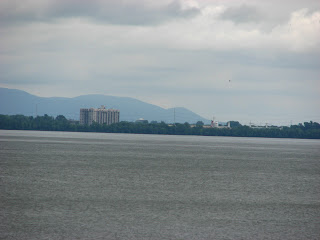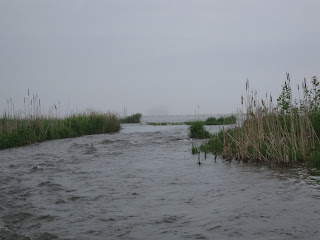Above: tentative translation from French, a vegetable warehouse (19th century). Several of these can be seen on route 360 near Chateau-Richer.
Above: tiny chapel seen on route 360 near Chateau-Richer.
Past the Cote de Beaupré area the route 138 suddenly attack the mountains of Charlevoix and follow
their landscape. At several point on the 138 you can get access to the St-Lawrence estuary by following the roads that goes perpendicular to the 138 and that leads to small villages that sits on the estuary. Here are some pictures of the road that leads to Petite-Rivière St-Francois (maybe 60 km downstream Quebec city).
Above: Canoeing landing spot is circled. Colored code map is from canoeing association Fédération Québecoise de Canot-Camping.
Above: Canoeing landing spot is circled. Colored code map is from canoeing association Fédération Québecoise de Canot-Camping.
Above: the roads that allow access to the St-Lawrence estuary from the route 138 are typically a bit rough on the brakes. Keep your speed low and use the drive 2 on your transmission when needed.
Above: emergency exit if brakes goes off. Of course no one wants to see how it goes for real if the brakes take a brake.
Above: the St-Lawrence estuary in sight.
Above: the Petite Rivière St-Francois municipal quay. Cargos are common on the estuary. To get access to the quay turn left after the village church. You can park on the quay. Went canoeing from the quay. Locals are not familiar with people canoeing on the estuary. They will typically inquire to see what level of awareness someone has about the estuary (tidal cycle, sudden change in wind direction etc). So to keep them without worry I said ''I will canoe near the coast and I will go counter-tide''.
Above: view of Petit Rivière St-Francois church during daytime.
Above: view of the church during sunset.
Above: high tide upstream of the quay.
Above: high tide downstream of the quay.
Above: low tide upstream of the quay.
Above: low tide downstream of the quay
Above: all the big rocks seen at low tide here and almost everywhere on the banks are gone at high tide.
Above: canoeing downstream the estuary should bring someone in theory into the real open sea.
Here are some pictures of two prototypical small Charlevoix rivers.
Above: covered bridge at St-Placide de Charlevoix on the Bras du Nord-Ouest river. Parking possible beside the bridge. To access the bridge, follow the covered bridge sign on route 138 at around 1 km west of the road that leads to Petite Rivière St-Francois. Trout fishing possible with a provincial fishing permit.
Above: Rivière du Sot. It crosses the road that leads to Petite Rivière St-Francois when the road gets flat.
Walking on the rocks fairly easy. Of course its much more efficient to walk around in those types of rivers by getting your feet wet with a good pair of sports shoes and hiking sticks. To get access to the river by feet, walk into the woods on the left side of the bridge than down to the river when the steepness of the bank gets less severe.
Above: river landscaping done on the Rivière du Sot by I dont know who. Titans maybe. This can be observed maybe after a 45 min. walk from the bridge.
Above: How the h... did they manage to bring over these huge granite stones.
Following are two pictures from Rivière du Gouffre that runs into the village of Baie St-Paul. Baie St-Paul is an artist city. It probably has the largest number of famous painters tributaries in Canada. Rivière du Gouffre means more or less Canyon River. But upstream near Baie St-Paul it is easy to paddle upstream and if the current is too strong it is easy to walk on the bank or even in the middle of the river due to several shallow water spots. For canoe landing we turned right on St-Jean Baptiste street from route 138 in Baie St-Paul. After less then 1 km we then turned left on St-Edouard then first road on the right (there is a concrete factory on the corner). Parked near the fence. For access to the river, by feet turn right after the fence then you should see an opening in the woods that allow canoe landing. Here are two pictures of the rivière du Gouffre. The Canyon that gave its name to the river must be much more upstream of Baie St-Paul.
Above: canoeing landing spot is circled. Colored code map is from canoeing association Fédération Québécoise de Canot-Camping.
Above: canoeing landing spot is circled. Colored code map is from canoeing association Fédération Québécoise de Canot-Camping.
Above: downstream view from the island.



































